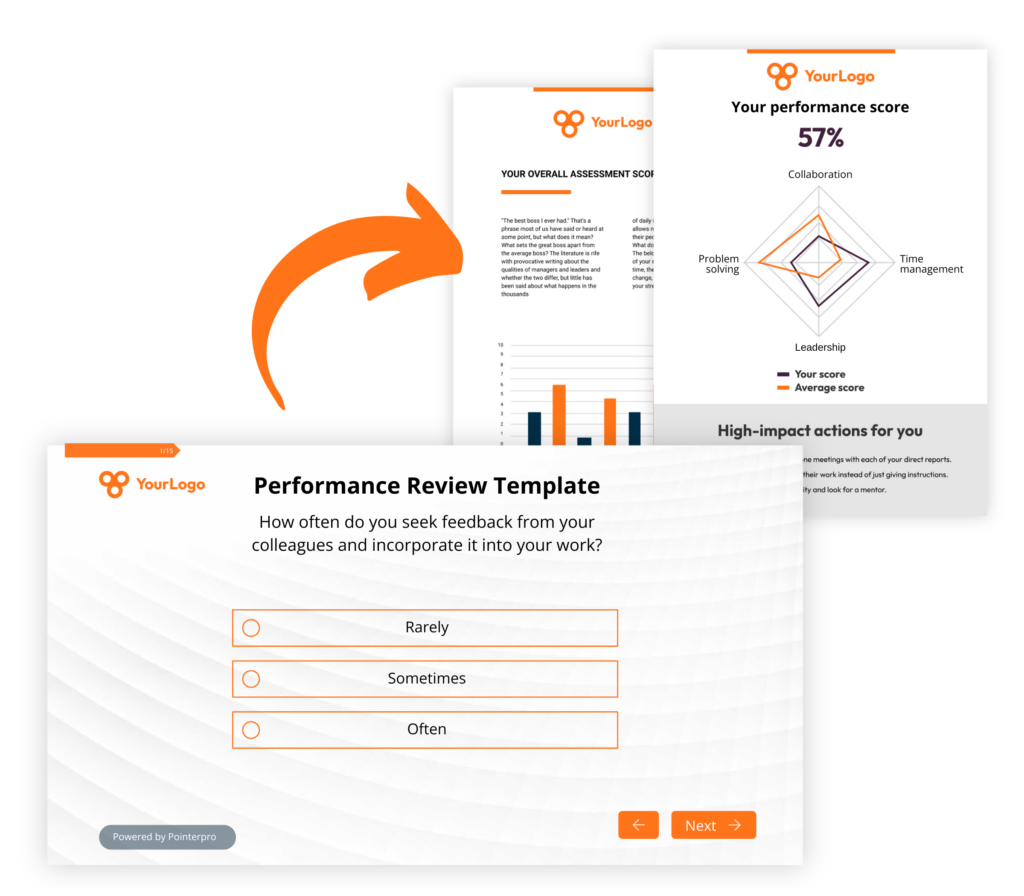A performance review is only as effective as the feedback you give and the actions you define to move forward.
It’s no different when you digitalize your performance review process. Start building that process now.
Pointerpro is the 2-in-1 software that combines assessment building with personalized PDF report generation.

In summary, there are 3 steps:
3 reasons to use Pointerpro as a performance review tool
Thanks to your setup in the Report Builder, respondents get a detailed individual report with personalized and objective feedback. This can also be aggregated feedback from different peers or managers.
1.500+ businesses worldwide build assessments with Pointerpro









In reality, we see most companies that use Pointerpro take the best from both worlds: They integrate both self-assessments and 360-degree feedback into their online performance review processes.
Why? Because it leverages the benefits of each approach. Self-assessments tend to serve as a foundation for individuals to evaluate their own performance, while 360-degree feedback provides additional insights and perspectives from colleagues and maybe from various managers. By combining these methods, organizations create a more robust and balanced evaluation process that supports employee growth and organizational success.
Whatever list of questions you end up with in your performance review template, follow these key tips:
The approach of these performance review template questions centered on ensuring relevance, objectivity, and comprehensive coverage. Each question was carefully crafted to directly address observable behaviors and actions relevant to an individual’s performance within a team or organizational context.
By focusing on specific behaviors rather than subjective judgments or personality traits, the questions aim to gather constructive and actionable feedback. Additionally, the questions are designed to solicit input from multiple perspectives, including colleagues, peers, and team members, to provide a holistic view of the individual’s performance.
It’s all about striking a balance between acknowledging strengths and identifying areas for improvement, ensuring that the feedback received was both affirming and supportive of the recipient’s professional development goals. Ultimately, the goal is to provide feedback that not only assesses performance but also facilitates personal growth and enhancement of skills and capabilities within the organization.
These performance review template questions prioritize relevance to a specific project context, as well as the employee’s contributions and growth opportunities. Each question is designed to prompt reflection on the project’s objectives, challenges, and outcomes, while also encouraging self-assessment of key skills such as communication, collaboration, time management, and problem-solving.
By focusing on the employee’s individual experience and achievements within the project, these questions aim to provide a meaningful framework for self-assessment and professional development.
These performance review template questions are designed to constitute 360-degree feedback report for people in leadership positions in your company. The approach is focused on gathering input from multiple perspectives within the organization, including colleagues, peers, direct reports, and supervisors.
Each question is therefore designed to assess specific leadership competencies and behaviors, such as communication, empathy, empowerment, conflict resolution, inclusivity, role modeling, innovation, change management, and relationship-building. By soliciting feedback from various stakeholders, the aim is to provide a comprehensive and well-rounded assessment of the leader’s effectiveness and impact on the team or organization. This is what ultimately suppors their growth and development as leaders.
"We use Pointerpro for all types of surveys and assessments across our global business, and employees love its ease of use and flexible reporting."

Director at Alere
"I give the new report builder 5 stars for its easy of use. Anyone without coding experience can start creating automated personalized reports quickly."

CFO & COO at Egg Science
"You guys have done a great job making this as easy to use as possible and still robust in functionality."

Account Director at Reed Talent Solutions
“It’s a great advantage to have formulas and the possibility for a really thorough analysis. There are hundreds of formulas, but the customer only sees the easy-to-read report. If you’re looking for something like that, it’s really nice to work with Pointerpro.”

Country Manager Netherlands at Better Minds at Work
By following these principles, you’ll be able to establish effective goals and key actions that drive performance, support employee development, and contribute to overall organizational success.
